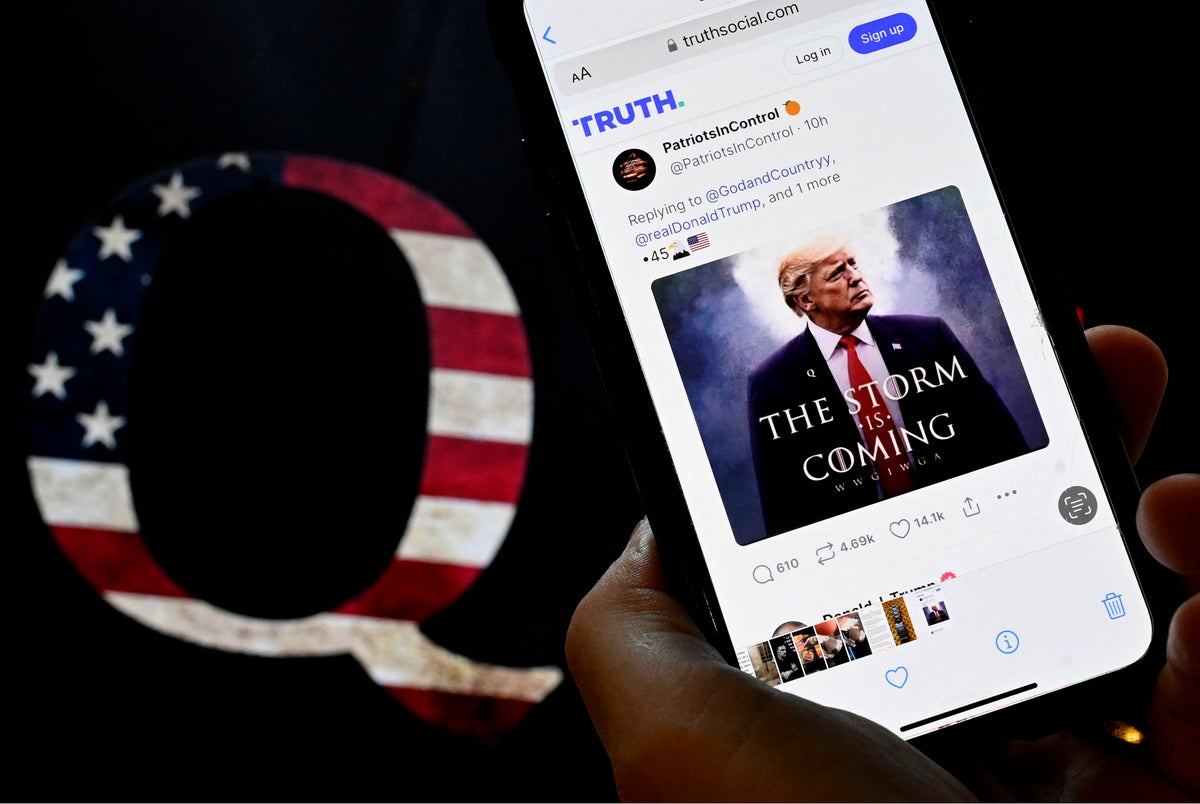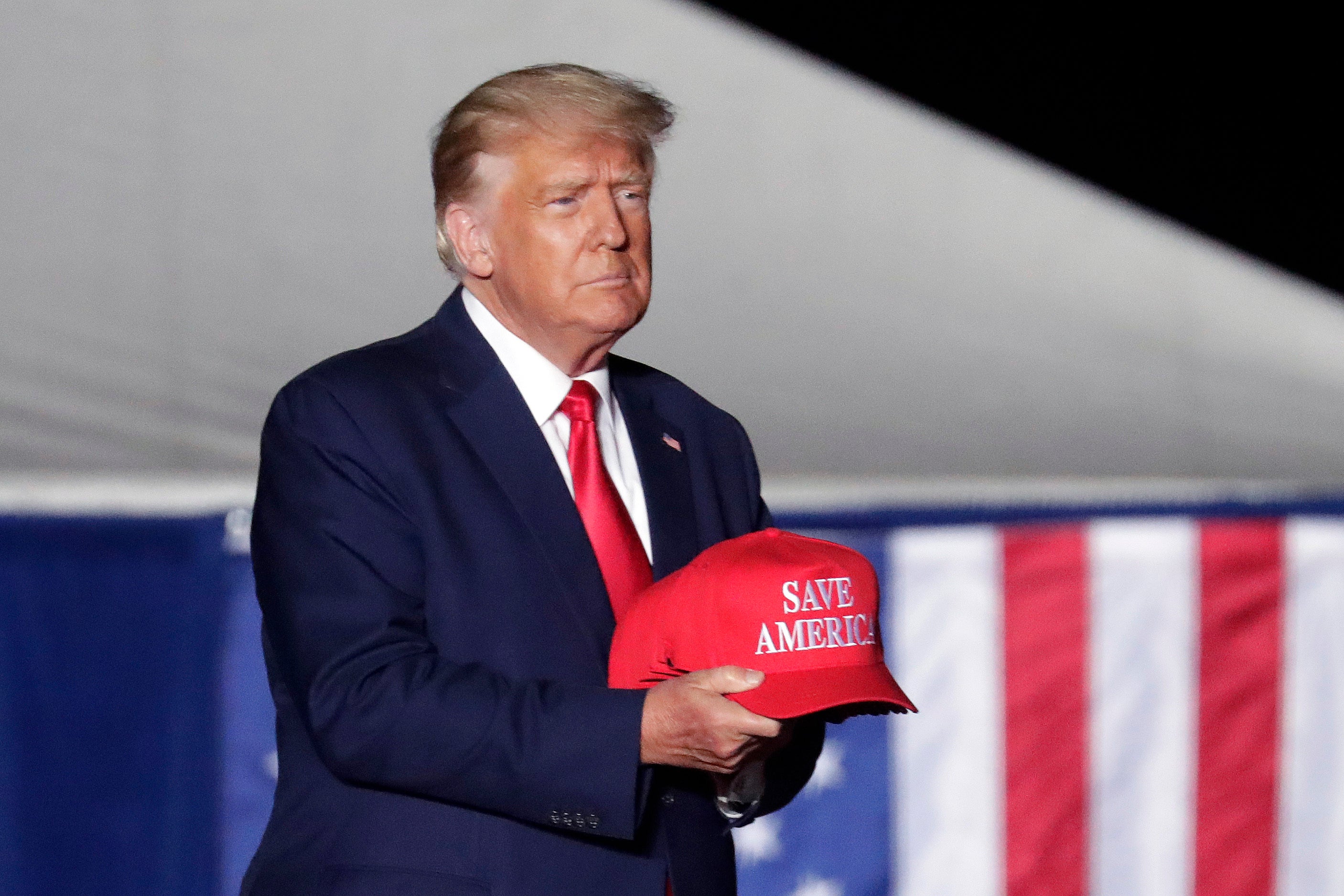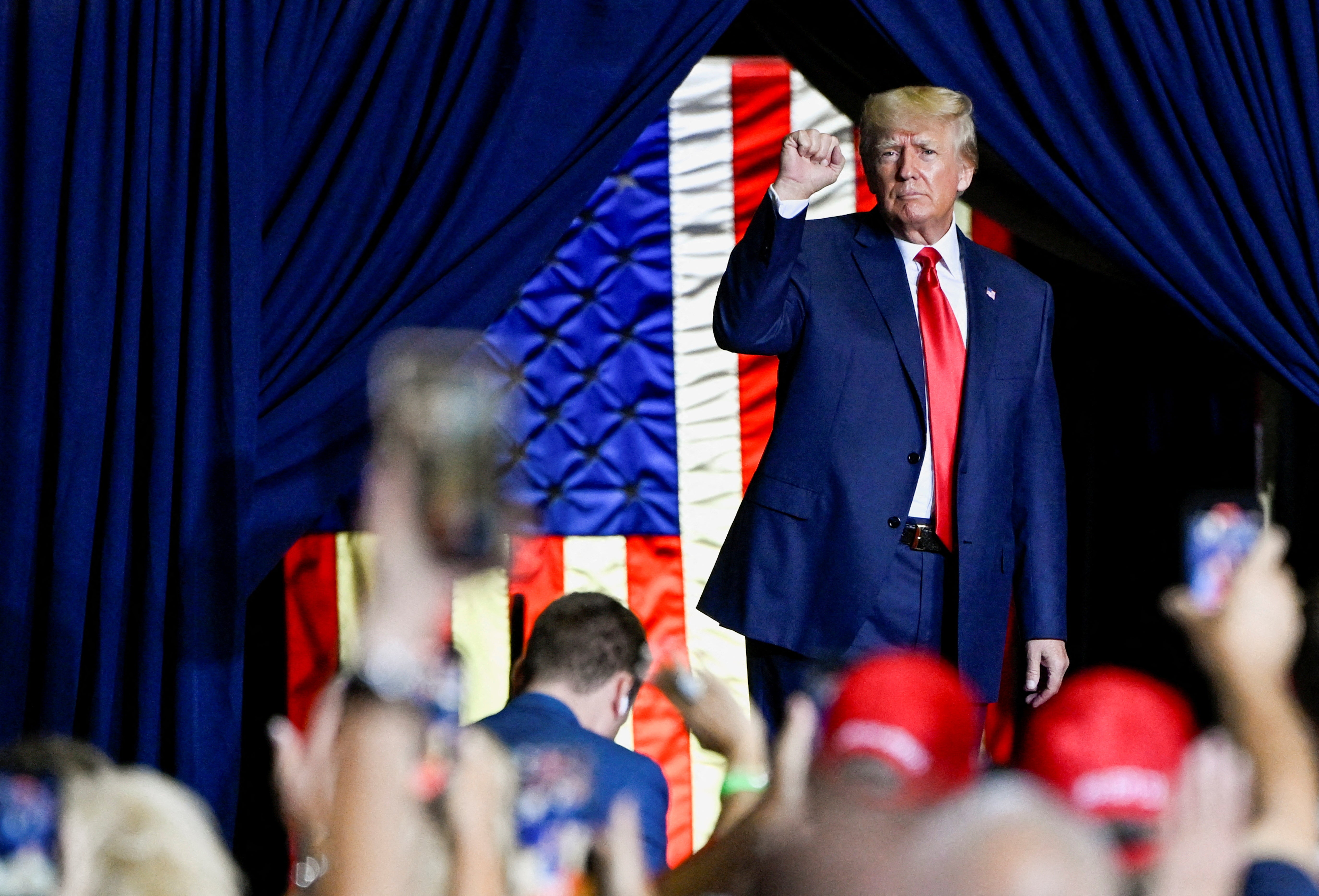
At former president Donald Trump’s rally in Wilmington, North Carolina, last week, plenty of supporters wore memorabilia or shirts featuring the former president’s visage saying “I’ll be back,” implying he would run again in 2024.
Some carried the slogan “Let’s go Brandon” – shorthand for “F*** Joe Biden” among the MAGA faithful – while others said “Joe and the Hoe Gotta Go,” a crude reference to Vice President Kamala Harris.
But among the hordes of supporters were devotees of the QAnon conspiracy – the right-wing movement that postulates that the former president was trying to thwart a satanic paedophile ring that has since swallowed up various other unfounded ideas.
One Cadillac SUV featured a mural of Mr Trump along with former president John F Kennedy and his son John F Kennedy Jr, whom some QAnon adherants believe is still alive and a leader of the movement. Similarly, one person had a “Q” patch on their jacket, while a few people in the audience at the Aero Center wore black baseball caps with the letter “Q.”
The former president – who has more than 4 million followers on his Twitter clone Truth Social – and his close associates have shared dozens of QAnon-affiliated posts on the platform within the first several months after its launch, according to a report from NewsGuard, including on the day of the rally.
As a result, at the rally at Wilmington, supporters like Lisa Pyle were pleased at his increasingly overt signalling toward them.
“I think it’s wonderful,” she said.
Ms Pyle was explicit that proper terminology was not “QAnon” but simply “Q”.
QAnon’s sweeping conspiracy theory community is bound by a far-reaching set of beliefs, with Mr Trump as its messianic figure, working against a “deep state” to destroy his political enemies.
“Whatever operations are going on is covert, so we don’t know,” Ms Pyle told The Independent.

Followers have thrived on other social media platforms despite being banned from more traditional venues, but they have the attention of the man at the centre of their conspiracy theories on Truth Social.
NewsGuard, a media watchdog focused on misinformation, identified 88 users, each with more than 10,000 followers, who have promoted QAnon memes and ideas on the platform. More than one third were previously banned by Twitter.
As The Independent previously reported following the platform’s formal launch, hashtags related to the QAnon slogan “where we go one we go all” were easily found among hundreds of posts within weeks of its launch.
Profiles dedicated to “the great awakening” – the ascendance of a far-right renaissance with Mr Trump at the helm – and other QAnon-referencing accounts were easily searchable through the platform’s account search function.
Indeed, toward the end of the rally, Mr Trump displayed American flags on the screens on both ends of the stage while the song “Mirrors” by Will Van De Crommert – which bears similarities to the QAnon song “Where We Go One, We Go All” – played. Mr Trump had previously played this music in Youngstown, Ohio, which led to rally attendees raising up one finger, seen as a signal to the QAnon movement. Some critics have argued that it resembles a Nazi salute, while supporters have claimed it’s an act of solidarity.

But in North Carolina, fewer attendees held up their fingers. PBS NewsHour’s Lisa Desjardins reported later that a guest management staffer for the Colorado Security Agency told an attendee to put his finger down.
The Washington Post later reported that these staffers, often clad in tight green shirts and slacks, quelled people from raising their fingers and tried to restrict QAnon adherents from blocking aisles with their dancing, a signal that Mr Trump’s team is at least somewhat aware of the movement’s potential to alienate supporters.
The Independent has reached out to the Colorado Security Agency for comment.
Supporters of QAnon have reason to believe Mr Trump is on their side. In recent weeks, the former president’s Q posts have been more explicit, such as a video telling viewers to “prepare for the storm” (Q adherents believe a cataclysmic “storm is coming” to eradicate political enemies before the “great awakening”).
“Trump has done a little flirting with Q over the years but it really struck us … how invested he seemed in it,” NewsGuard editorial director Eric Effron told The Independent.
The report was published just before a wave of Q-related content appeared on the former president’s profile and at his rallies. One month after the report, “there is no evidence that he’s moving away from this”, Mr Effron said.
Mike Fox, who ran a Q booth outside the Aero Center in Wilmington, praised Mr Trump’s adoption of the language of QAnon adherents.

“I think it’s about time ... we need the truth to come out, whether people like it or not,” he told The Independent.
And there might be consequences for Republicans electorally – and not just because some QAnon adherents like Ms Pyle don’t want to vote. Gunner Ramer, the political director of the anti-Trump Republican Accountability Project, said that while QAnon is not the only thing that alienates swing voters, the Q affiliation does repel some.
Mr Ramer noted how Republican candidates across the country also have ties to QAnon, such as Mark Finchem, who is running for secretary of state in Arizona, and Jim Marchant, the GOP nominee for secretary of state in Nevada.
“They all have ties to QAnon and that’s not going to help with swing voters,” he told The Independent. “QAnon is not the only thing that is alienating them but it can be a part of that.”
“I don’t know where that’s coming from but it’s definitely troubling that he’s doing all these winks and nods to QAnon,” he added. “I’m not sure why that started to pick up but what I can say is that sort of things is not going to help win elections.”
Similarly, former Congressman Denver Riggleman, who worked for the House committee investigating the January attack, told 60 Minutes that seeing text messages from conservative activist Virginia “Ginni” Thomas that promoted QAnon theories showed how embedded the theory is in the GOP’s DNA.
“It is an infection,” he told the programme, adding that her text messages to former White House chief of staff Mark Meadows “should be an eye opener for everybody”.
Truth Social – unlike Telegram and Gab, where far-right personalities and their followers have similarly created their own online ecosystems largely removed from reality – has one critical feature: Donald Trump himself.
“If you’re a true adherent and really believe Trump is in the fight … with Q to root out paedophiles and Satan-worshippers, being on the same platform with him and interacting with him is exciting,” Mr Effron said. “If you’re a Trump fan, especially a Trump fan who’s angry at the mainstream platforms, [one] could see that as a motivating factor.”
Twitter announced the suspension of thousands of QAnon-linked accounts in the aftermath of the Capitol attack, fuelled by the former president’s ongoing and baseless narrative that the 2020 election was “stolen” from him.
Many of those users have thrived on other platforms, while the central tenets of QAnon – alleging widespread voter fraud and a belief that Mr Trump is battling a “deep state” controlling the government – have become enmeshed in mainstream Republican politics.
Conspiracy theorist Ron Watkins, the site administrator of a message board that facilitated posts from the “Q” persona but has denied accusations that he himself has posted as Q, has developed a following on Telegram following his ban from Twitter.
He also joined Truth Social, where he has not posted since losing his Republican congressional primary bid in Arizona. His father Jim Watkins, the site owner of the 8kun message board, is active on the platform.
NewsGuard also found that current and former Truth Social executives are sharing explicit QAnon content, including the chief executive of the acquisition company poised to take Trump Media & Technology Group public.
Digital World Acquisition chief Patrick Orlando shared messages from other users promoting the “where we go one we go all” slogan, including one post with an American flag emblazoned with the catchphrase.
A threat assessment from federal law enforcement agencies last year warned against real-world violence sparked by conspiracy communities like QAnon. Several defendants tied to the January 6 attack have discussed QAnon and conspiracy theories that have laid the foundation for its central tenets.
A man who was fatally shot by police during an attempt to breach an FBI field office in Ohio posted a “call to arms” on Truth Social days before the attack, according to NewsGuard.
At least three accounts that the man, Ricky Shiffer, interacted with on the platform shared QAnon-related content, including one user who was amplified by Mr Trump at least 12 times, including three times since after the attempted attack on the FBI office, according to NewsGuard.
Truth Social removed Shiffer’s account following the incident.
Samuel Woolley, who leads the Propaganda Research Lab at the University of Texas-Austin and is the author of The Reality Game: How the Next Wave of Technology Will Break the Truth, says Truth Social has facilitated Mr Trump and his supporters’ “steady march towards even deeper conspiracy theories and towards the right”.
“There’s this whole alternative ecosystem of social media … and clones of social media platforms to host conspiracy theory content” under the umbrella of their permissive “free speech” guidelines, he told The Independent.
“Now that Trump has started Truth Social and invested himself there, he has been much more overt with his mentions of Q and QAnon conspiracies, moreso than when he was on mainstream social media platforms,” he said. “This moves him and his base further from reality.”
That “asymmetric polarisation” has enabled a large audience to digest news and information in a parallel reality, one where “they not only don’t get exposed to the same framing of the story, they don’t exposed to the story at all,” according to Mr Woolley.
Disrupting those echo chambers is notoriously difficult. People living within them have developed an extremely dense aversion to information from people and institutions they perceive as unreliable or against them.
Cutting through conspiracy theories requires longer-term, genuine outreach oriented towards compassion and acceptance, Mr Woolley said.
“Conspiracy theories and conspiracy thinking is like getting off the wrong exit too soon before critical thinking,” according to Mr Woolley. “Because people have bought into this so deeply, you can’t simply fact check them.”







